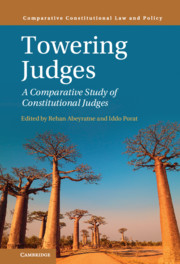Book contents
- Towering Judges
- Comparative Constitutional Law and Policy
- Towering Judges
- Copyright page
- Dedication
- Contents
- Acknowledgements
- Contributors
- Introduction: Towering Judges – A Conceptual and Comparative Analysis
- 1 Towering Judges and Global Constitutionalism
- 2 The Landscapes that Towering Judges Tower Over
- 3 Sir Anthony Mason: Towering Over the High Court of Australia
- 4 Lady Hale: A Feminist Towering Judge
- 5 Hugh Kennedy: Ireland’s (Quietly) Towering Nation-Maker
- 6 Judicial Rhetoric of a Liberal Polity: Hong Kong, 1997–2012
- 7 Judicial Minimalism as Towering: Singapore’s Chief Justice Chan Sek Keong
- 8 Nepal’s Most Towering Judge: The Honourable Kalyan Shrestha
- 9 Barak’s Legal Revolutions and What Remains of Them: Authoritarian Abuse of the Judiciary-Empowerment Revolution in Israel
- 10 PN Bhagwati and the Transformation of India’s Judiciary
- 11 Justice Cepeda’s Institution-Building on the Colombian Constitutional Court: A Fusion of the Political and the Legal
- 12 A Towering but Modest Judicial Figure: The Case of Arthur Chaskalson
- 13 Chief Justice Sólyom and the Paradox of “Revolution under the Rule of Law”
- 14 The Socialist Model of Individual Judicial Powers
- 15 The Civil Law Tradition, the Pinochet Constitution, and Judge Eugenio Valenzuela
- 16 Towering versus Collegial Judges: A Comparative Reflection
- Appendix
- Index
13 - Chief Justice Sólyom and the Paradox of “Revolution under the Rule of Law”
Published online by Cambridge University Press: 25 March 2021
- Towering Judges
- Comparative Constitutional Law and Policy
- Towering Judges
- Copyright page
- Dedication
- Contents
- Acknowledgements
- Contributors
- Introduction: Towering Judges – A Conceptual and Comparative Analysis
- 1 Towering Judges and Global Constitutionalism
- 2 The Landscapes that Towering Judges Tower Over
- 3 Sir Anthony Mason: Towering Over the High Court of Australia
- 4 Lady Hale: A Feminist Towering Judge
- 5 Hugh Kennedy: Ireland’s (Quietly) Towering Nation-Maker
- 6 Judicial Rhetoric of a Liberal Polity: Hong Kong, 1997–2012
- 7 Judicial Minimalism as Towering: Singapore’s Chief Justice Chan Sek Keong
- 8 Nepal’s Most Towering Judge: The Honourable Kalyan Shrestha
- 9 Barak’s Legal Revolutions and What Remains of Them: Authoritarian Abuse of the Judiciary-Empowerment Revolution in Israel
- 10 PN Bhagwati and the Transformation of India’s Judiciary
- 11 Justice Cepeda’s Institution-Building on the Colombian Constitutional Court: A Fusion of the Political and the Legal
- 12 A Towering but Modest Judicial Figure: The Case of Arthur Chaskalson
- 13 Chief Justice Sólyom and the Paradox of “Revolution under the Rule of Law”
- 14 The Socialist Model of Individual Judicial Powers
- 15 The Civil Law Tradition, the Pinochet Constitution, and Judge Eugenio Valenzuela
- 16 Towering versus Collegial Judges: A Comparative Reflection
- Appendix
- Index
Summary
The Hungarian constitutional democracy was born in 1989; the Constitutional Court commenced operation in 1990. László Sólyom, the first president of the Court, is thus considered a founder and developer of Hungarian constitutionalism. This chapter summarises Sólyom’s views on the characteristics of the 1989 constitutional transformation and the status of the Constitutional Court. It then examines his leading judgments and dissenting opinions, offering an explanation of his views on the judiciary, constitutional interpretation, and fundamental rights. Finally, it shows how Sólyom changed his point of view on key constitutional issues when serving as the head of state during the last years of the Republic of Hungary. The chapter rejects the popular view that Sólyom, as a liberal thinker and judge, consolidated the liberal democracy in Hungary. It also rejects the opposite claim that Sólyom’s judicial activism led to backsliding from liberal democracy. Instead, the chapter argues that, although his merits as leader of the first Hungarian Constitutional Court should be fully recognised, Sólyom’s legacy involves many paradoxical elements, for which it offers an explanation.
Keywords
- Type
- Chapter
- Information
- Towering JudgesA Comparative Study of Constitutional Judges, pp. 255 - 274Publisher: Cambridge University PressPrint publication year: 2021
- 1
- Cited by

